by Editor | Sep 26, 2011 | Luxury Travel
Article and photos by Josette King
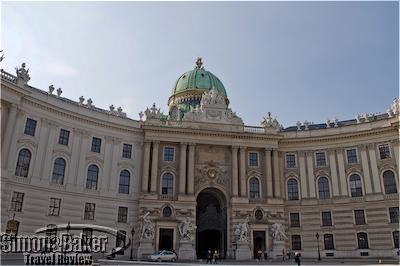
Main façade of the Hofburg imperial palace in Vienna
There is always a risk in revisiting best-loved places that they may have changed. My first encounter with Vienna dates back to the 1960’s. The shine of the once brilliant capital of the Habsburg Dynasty had been dulled by the aftermath of two world wars; but even so, it had managed to retain enough of its past grandeur and courtly traditions to seduce me on the spot. I returned several times over the ensuing decades and with each visit, I delighted in observing an accelerating pace of renaissance. Palaces were restored to their imperial majesty; and in the center of town, new constructions were sensitively integrated into their historic surroundings; Vienna has indeed changed over the recent past, but only for the better. Today it is again a sparkling jewel in the center of Europe, the 21st century version of the exuberantly luxurious and romantic capital of its imperial heydays.
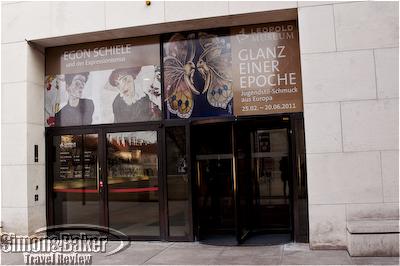
The Leopold Museum
I hadn’t been back in over a decade, so the intent of my recent visit was to catch up with this new, 21st century Vienna and more specifically visit the Leopold Museum. Opened in 2001 to hold the previously private art collection of Rudolph and Elizabeth Leopold, it is a treasure trove of Austrian Modernist masterpieces, including the world’s largest collection of the works of Egon Schiele, recognized as one of the greatest figurative painters of the early 20th century. Although he died at the age of 29 in 1918, Schiele left an amazing body of work that had been all but forgotten until local art collector Rudolph Leopold rediscovered him in the 1950. Today 330 of his oil canvases and over 2,500 of his drawings are part of the Leopold’s collection. Many of his major works are permanently on display along with a number of paintings by Gustav Klimt, Oskar Kokoschka and other leading artists of the Austrian Modernism movement. The museum also includes a stunning collection of Art Nouveau jewelry and crafts.
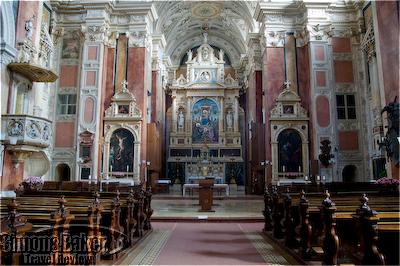
Baroque churches abound in Vienna
Another exciting discovery was the extensive renovation work that had been completed on the Kärntner Ring section of the Ringstrasse (or simply the Ring), the broad 19th century boulevard that circles the center of the city. At the time of its construction, the Ring had been lined with palaces, public buildings and several landmark hotels. Some of the latter had over time fallen into serious disrepair, some to the point of being boarded up for a time. Since my last visit, two of these hotels, the Grand Hotel Wien and the Ring Hotel had been restored to their original splendor.
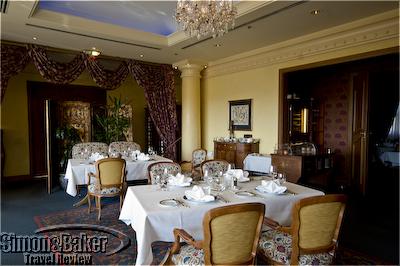
Le Ciel dining room at Grand Hotel Wein
Behind its superb classic facade, the Grand Hotel Wien, the first luxury hotel in the city when it first opened its doors in 1870, once again welcomed its guests to palatial interior spaces, Viennese Grand Style décor and the impeccable service that spoke of the opulence of a bygone area. Meanwhile just across the street, the Ring Hotel, once a residential property that had provided in-town pieds-à-terre for bachelors of the Viennese aristocracy, had undergone a complete interior reconstruction. It had re-opened in 2007 as a contemporary luxury hotel appointed with the latest amenities, including a state-of-the-art health club and spa tucked under the eaves, and a sauna with a glorious view over the rooftops of the city. It was a perfect place to enjoy some of the best of contemporary Vienna within a few minutes’ walk from the significant historic and artistic landmarks in the city. Visit the Simon & Baker Travel Review to read more about my recent visit to Austria, the Grand Hotel Wien and the Ring Hotel.
by Editor | Sep 19, 2011 | Luxury Travel
Article and photos by Josette King
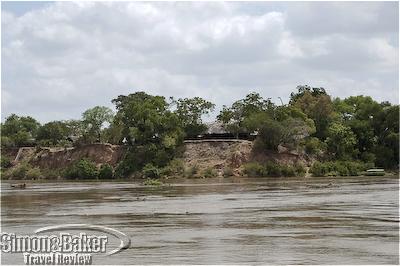
Rufiji River Camp was stretched high on a bluff
After a visit to Katavi in the farthest reaches of western Tanzania, I flew to the Selous Game Reserve. It was a long way back east from Katavi to Selous, several hours including a stop-over in Ruaha, which gave me time to collect myself and re-enter the 21st century. Located in southeast Tanzania, the Selous Game Reserve covers more than five percent of Tanzania’s total landmass. It is the largest protected and one of the oldest wildlife reserves in Africa. It was first established over a century ago as a hunting reserve, and large portions to the south of the Rufiji River are still set aside for hunting, while the northeastern part of Selous is dedicated to photographic tourism.
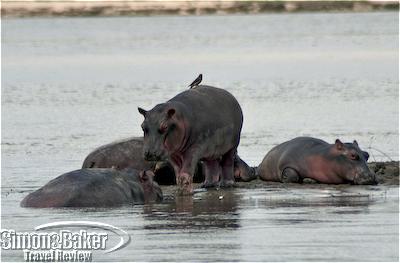
The river was filled with hippos
The remote location limits the number of visitors, although I found Selous to be relatively more crowded than anywhere else I visited in the Southern Circuit. In addition to being home to the Rufiji River and to its remarkable abundance of game and bird life, what made Selous unique was its status as a game reserve. It permitted a larger range of activities than in the more regulated national parks.
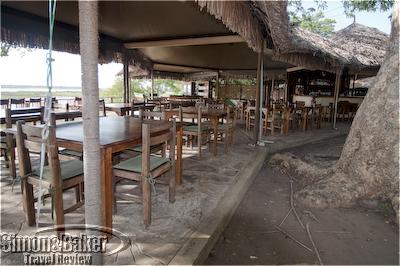
The dining area at Rufiji
The Rufiji River Camp made the most of this advantage. Stretched along a bluff overlooking the river, the camp delivered an outstanding variety of game viewing activities. Game drives in the camp’s open-sided vehicles were especially rewarding as it was possible to go off-road for optimum viewing. The camp also offered river safaris in open-sided pontoon boats, and walking safaris. A favorite activity of mine was the siesta time armchair safaris I enjoyed on my private veranda which overlooked an active pod of hippos and the riverbank where elephants came to drink and crocodiles lazed in the sun. Meanwhile every rustle in the trees above my tent was a new birding opportunity.
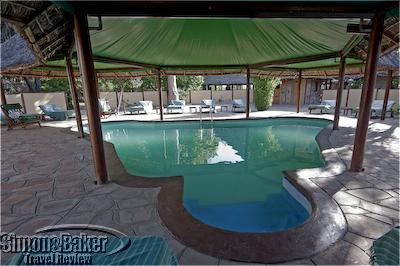
A thatched roof shaded the bell-shaped pool
Visit the Simon & Baker Travel Review for more about my recent visit to Tanzania and the Rufiji River Camp.
by Editor | Sep 12, 2011 | Accomodations, Ecotourism, Food and Wine, New Articles
By Elena del Valle
Photos by Gary Cox and Elena del Valle
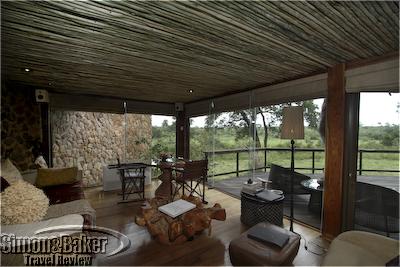
The suite at Boulders featured a stunning view of the bush
We ended our visit to South Africa’s premier game viewing area earlier this year with three nights at the Singita properties in the Sabi Sand Reserve. We spent the first two nights at Singita Ebony and the last night, the first night they were open following a soft refurbishing closure, at Singita Boulders. Our experience was superb.
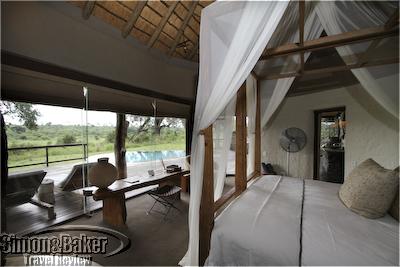
The master bedroom and private pool at Singita Boulders
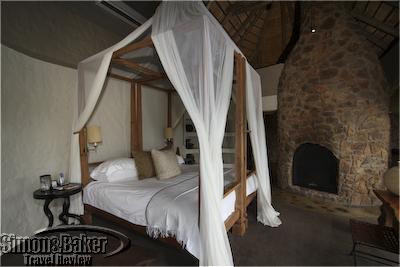
The master bedroom at Boulders featured a wood burning fireplace
At Ebony we enjoyed an informative and fun wine tasting with Francois Rautenbach, the company’s wine manager, in the lodge’s cozy cellar. During the hour long event, shared with four other guests, we heard about South Africa’s varied wine regions and the wines they produce, the evolution of the country’s wine industry and some of the salient wines that are garnering international recognition.
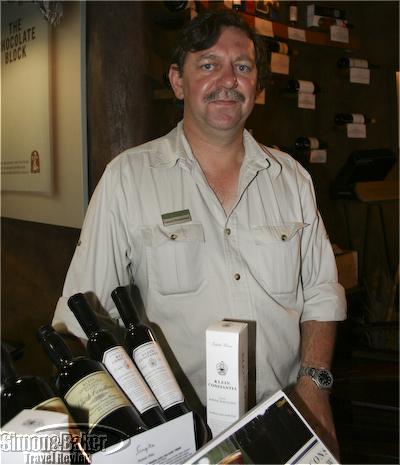
Francois Rautenbach, Singita’s wine manager
During the tasting, we had a chance to sample four wines, selected by the staff, before our tasting menu dinner. We began with a 2008 Director’s Reserve White from Tokara in Simonsberg-Stellenbosch made of 85 percent sauvignon blanc and 15 percent semillon and a 2009 Aeternitas Wines Blanc from Voor-Paardeberg made of 90 chenin blanc, 5 percent viognier and 5 percent grenache blanc.
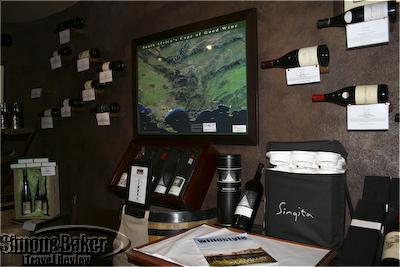
The Singita shop carried wine and related merchandise
Next we had two 2003 wines, a Sequillo Cellars blend of syrah, mourvedre and grenache from the West Coast and Paarl regions and a Rij’s Private Cellar Bravado blend of 21 percent cabernet, 7 percent cabernet franc, 12 percent merlot, 35 percent shiraz and 25 percent pinotage from the Tulbagh Valley.

Singita staff prepared an eco-friendly meal by lantern light
At Boulders we joined fellow guests and the lodge staff, at the same time as guests and staff at Singita’s nine lodges in three countries, in an Earth Hour global event organized by the World Wide Fund for Nature on the last Saturday of March every year. The idea is to make it through one hour in the early evening without electricity to raise awareness about climate change.
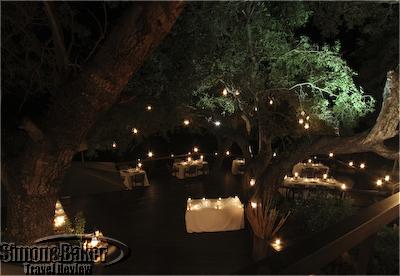
The dining area on the main deck prepared for Earth Hour
The local staff regaled us with a singing and dance performance and the kitchen made sure our dinner, prepared on the deck and served by candlelight was splendid. A company executive and a local news media team were on hand to share the moment with viewers across the country. Visit the Simon & Baker Travel Review for more about Singita Boulders and our visit to the Sabi Sand Reserve and Singita Ebony.
by Editor | Sep 6, 2011 | Luxury Travel
Article and photos by Josette King
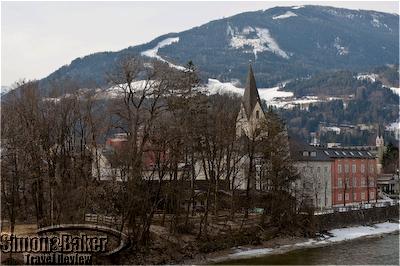
My suite overlooked the river and the mountain
I recently came upon Shangri La, crash landing in a lost Himalayan valley not required. My own Utopian mountain paradise was much more readily accessible. Nestled in a pristine valley between the Grossglockner (the highest Alpine peak in Austria) and the Dolomites, the tiny medieval town of Lienz was only a few hours away from Vienna, or Venice. Just a few minutes walk from the center of town along the crystalline waters of the Isel River, the last glacial stream in the Alps, the Grandhotel Lienz was a cocoon of luxury where time and the aging process felt suspended. Although I visited during an exceptionally frigid winter spell, any climactic or indeed, any exterior world consideration faded into irrelevance the instant I entered the lovely white stone mansion-like property.

Reception foyer
The inclement weather was a welcome opportunity to linger longer in front of the dancing fire in the lounge; or enjoy the wintery views and crisp mountain air while dreamily floating around the huge heated outdoor whirlpool. What I liked best of all was to lose myself in the stunning two-level spa, with its multiple saunas and steam rooms, serene relaxation lounge and sophisticated treatment rooms where a staff of expert therapists offered a full range of superb massages and spa treatments.
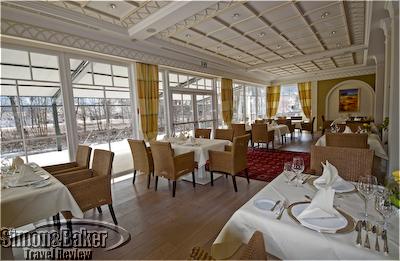
Orangerie dining room
The gourmet restaurant, with its sumptuous breakfasts and imaginative daily degustation dinner menu was further enticement never to leave the premises. As was my exquisite suite with its vases filled with fresh flowers, Nespresso coffee machine, and the oversize chaise thoughtfully angled to offer an equally enjoyable perspective of the mountain and the large LCD television screen.
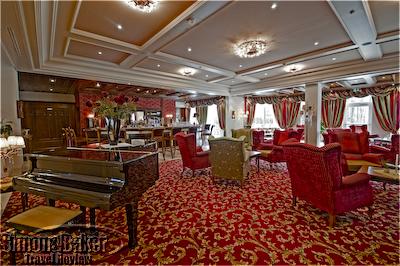
Lounge and bar
For those less slothfully inclined, Lienz was rich in natural and historical resources, with a 13th century castle just at the edge of town, and well preserved frescoes within its ancient churches. For the hardier souls, superb skiing awaited, with lifts right in the center of town to transport them up to the top of well-groomed, uncrowded slopes. Looking at the spectacular vistas that surrounded the area, it was easy to understand that this was prime four-season vacationing country, and a bucolic retreat where I would enjoy returning any season of the year.
Visit the Simon & Baker Travel Review to read more about my visit to Austria and Grandhotel Lienz.



























